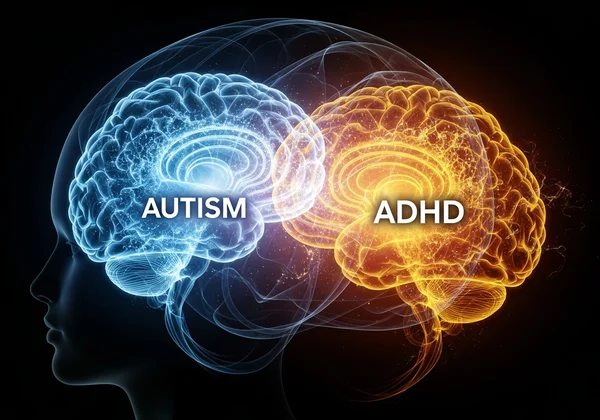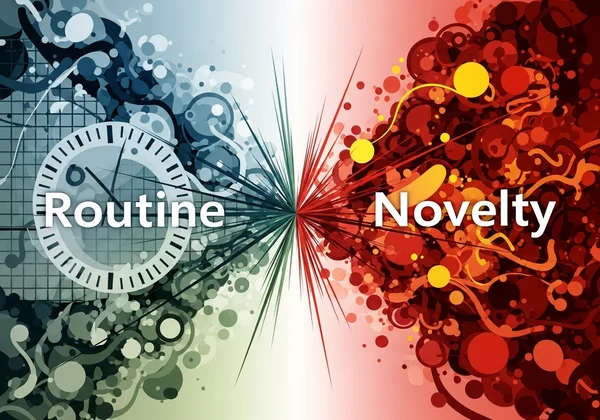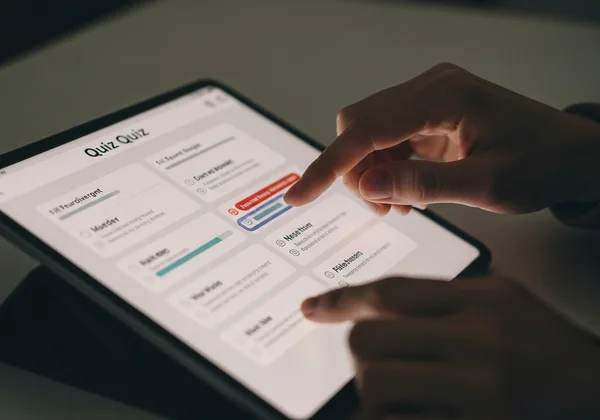AuDHD Test: Free Neurodivergent Test for Autism & ADHD Traits
Have you ever felt a unique push-and-pull within your mind, struggling to reconcile a deep need for routine with an insatiable craving for novelty? Perhaps you relate to both the intense focus often associated with autism and the restless energy of ADHD. You're not alone. This is the world of AuDHD, describing the experience of being both autistic and having ADHD. What are the signs of being neurodivergent? This guide will help you understand this complex intersection, explore common traits, and empower you to begin your journey of self-discovery.

Welcome to a space of understanding and validation. The experience of AuDHD is not about having two separate conditions; it's about how they interact to create a completely unique neurological profile. If you've spent your life feeling like a walking contradiction, this exploration might provide the clarity you've been seeking. To begin exploring your own unique profile, you can [take our free test] as a first step toward self-awareness.
What is AuDHD? Understanding the Dual Neurotype
AuDHD is a community-created term that signifies the co-occurrence of Autism and ADHD. It’s not a formal clinical diagnosis in itself, but rather a way to describe the lived reality of individuals who have been diagnosed with, or identify with the traits of, both neurotypes. Research shows a significant overlap, with many autistic individuals also meeting the criteria for ADHD and vice-versa. Understanding AuDHD means looking beyond separate checklists of symptoms and appreciating the dynamic interplay between them.
This dual profile creates a unique internal landscape. The autistic inclination toward structure, predictability, and deep focus can often feel at war with the ADHD drive for spontaneity, stimulation, and dopamine-seeking behavior. It’s this internal tension that defines much of the AuDHD experience, making it distinct from having just one or the other. This journey of understanding is a core part of what a [neurodivergence test] can help initiate.
The Overlap: How Autism and ADHD Traits Intersect
At first glance, autism and ADHD might seem like opposites. One is often stereotyped by quiet, predictable behavior, while the other is associated with hyperactivity and impulsivity. However, they share more common ground than many realize, particularly in areas of executive dysfunction. Both neurotypes can involve challenges with organizing tasks, managing time, and regulating emotions. Sensory processing differences are also common, though they may manifest differently.
For an AuDHD individual, an autistic need for a quiet, controlled sensory environment might clash with an ADHD brain that is under-stimulated and craving input. Similarly, the intense, singular focus of an autistic special interest can be powered by ADHD hyperfocus, leading to incredible bursts of productivity and creativity. But this same combination can also lead to inertia, where the autistic need for a perfect plan meets the ADHD difficulty in initiating tasks, resulting in a feeling of being "stuck."
Dispelling Myths: AuDHD Isn't 'More' Neurodivergent
A common misconception is that having AuDHD means someone is "more" autistic or "more" ADHD, or somehow more profoundly neurodivergent. This isn't accurate. It is simply a different neurocognitive profile. The traits don't just add up; they interact, mask, and compensate for each other in complex ways. For instance, the autistic desire to adhere to social rules might mask the impulsivity of ADHD, making it harder to recognize.
Viewing AuDHD as a unique combination rather than a hierarchy of neurodivergence is a core principle of the Neurodiversity Movement and is crucial for self-acceptance. It’s not about being more challenged; it’s about navigating a specific set of internal contrasts that neurotypical individuals, or even those with only autism or ADHD, might not experience. Recognizing this distinction is the first step toward embracing your unique brain.
Recognizing AuDHD Symptoms & Unique Experiences
Identifying AuDHD symptoms is less about checking boxes and more about recognizing patterns of internal experience. Many with AuDHD report feeling like they are constantly at odds with themselves, a sentiment that can be both confusing and exhausting. This internal conflict is a hallmark of the AuDHD profile.
These experiences are often deeply personal and can vary significantly from person to person. However, some common themes emerge that can provide a sense of validation for those wondering if this label fits. If you see yourself in these descriptions, an [am I neurodivergent test] can be a helpful tool for further exploration.
Navigating Internal Conflicts: Routine vs. Novelty
Central to the AuDHD experience is the ongoing battle between the desire for routine and an insistent craving for novelty. Your autistic side may meticulously plan the entire week, scheduling every task to create a sense of safety and predictability. But when the time comes to execute the plan, your ADHD side may find it unbearably boring and rebel, seeking out a new, more exciting activity instead.
This can lead to cycles of ambitious planning followed by frustration and self-criticism when those plans fall apart. It can also manifest as a love-hate relationship with schedules. You know you need them to function, but you also feel constrained by them. This constant push-and-pull requires immense mental energy to manage day-to-day.

Masking and Burnout: The Hidden Toll of AuDHD
Masking, or camouflaging neurodivergent traits to fit in with neurotypical expectations, is a common experience for many neurodivergent people. For those with AuDHD, it becomes an even more complex performance. You might be simultaneously suppressing autistic stims (like hand-flapping) while also trying to rein in ADHD fidgeting and impulsivity. This requires a constant, exhausting level of self-monitoring.
This sustained effort often leads to a profound state of exhaustion known as autistic burnout. When combined with ADHD-related burnout from over-committing and dopamine crashes, the result can be debilitating. It’s far more than just feeling tired; it’s a complete shutdown of executive function, social capacity, and emotional regulation, often stemming from the chronic stress of not living authentically.

Unlocking Strengths: The AuDHD Advantage
While the challenges are real, the AuDHD brain also possesses a remarkable set of strengths. The combination of autistic deep-dive thinking with ADHD's associative, non-linear creativity can lead to incredible innovation and problem-solving skills. AuDHD individuals are often the ones who see connections that others miss.
The ability to hyperfocus on a topic of interest is supercharged in the AuDHD brain. This intense concentration, fueled by both autistic passion and ADHD's dopamine-driven focus, can lead to mastery in specialized fields. Furthermore, many AuDHD individuals report a deep sense of justice and empathy, combining an autistic analytical view of fairness with an ADHD passion for action.

Exploring Your Traits: Taking an AuDHD Neurodivergent Test Online
If these experiences resonate with you, the next logical step is to seek more clarity. An autism and adhd test taken online can be a powerful, low-barrier starting point. These tools are designed not to diagnose, but to help you identify and understand your own traits in a structured way.
The goal of a preliminary screening is to provide you with a framework for your feelings and experiences. It can be an incredibly validating moment to see your lifelong patterns reflected in the results. This validation is a key part of the journey toward self-acceptance. Ready to see what insights you might gain? You can [explore your traits] right now.
What an Online AuDHD Quiz Can Tell You

An online neurodivergent traits quiz serves as a mirror, reflecting patterns you may not have had the language to describe before. It can highlight areas where your experiences align with common AuDHD traits, covering social preferences, sensory sensitivities, attention patterns, and organizational styles. The results can provide a personalized insight into your potential neurotype.
Remember, a quiz like our [free neurodivergent test] is a self-discovery tool, not a clinical diagnosis. It offers a starting point for exploration and a vocabulary to discuss your experiences. The true value lies in the empowerment that comes from understanding that you are not alone and that there is a name for your unique way of being.
Next Steps: Beyond the Initial Test to Professional Insight
After taking an online test, you may feel a strong sense of recognition. If your results suggest you have traits consistent with AuDHD and you wish to pursue a formal diagnosis, the next step is to consult with a qualified healthcare professional. This could be a psychologist, psychiatrist, or neuropsychologist experienced in diagnosing neurodevelopmental conditions in adults.
A professional evaluation can provide a definitive diagnosis, which may be necessary for accessing accommodations at work or school. More importantly, it can open the door to tailored support and therapies. For more information on advocacy and support, consider resources from organizations like the Autism Self Advocacy Network (ASAN) or CHADD (Children and Adults with Attention-Deficit/Hyperactivity Disorder). Use the insights from your initial test as a starting point to have a more informed conversation with a professional, empowering you to advocate for your own needs.
Embracing Your Unique AuDHD Profile
Understanding yourself as potentially AuDHD is a journey, not a destination. It’s about reframing your perceived flaws as intrinsic parts of your neurological makeup and learning to work with your brain instead of against it. Embracing your AuDHD profile means accepting the contradictions, celebrating the unique strengths, and having compassion for the challenges.
You are not broken, lazy, or "too much." You are a unique blend of traits that gives you a perspective on the world that is entirely your own. Your journey to self-understanding is a powerful act of self-acceptance. If you’re ready to take the first step, we invite you to start your journey and discover more about your incredible mind.
Frequently Asked Questions About AuDHD
What are the common signs of AuDHD?
Common signs include a constant internal conflict between needing routine and craving novelty, experiencing both intense hyperfocus and significant distractibility, social anxiety combined with a desire for connection, and heightened sensory sensitivities alongside sensory-seeking behaviors. Many also experience profound executive dysfunction and are prone to burnout from extensive masking.
How is AuDHD typically identified or diagnosed?
AuDHD is typically identified through a comprehensive diagnostic assessment with a clinician who specializes in neurodevelopmental conditions. This process often involves separate evaluations for Autism Spectrum Disorder (ASD) and ADHD. A skilled practitioner will then consider how the traits interact to form the individual's unique AuDHD profile.
Can someone have AuDHD and not know it?
Absolutely. Many people, especially those assigned female at birth or who are high-masking, go undiagnosed well into adulthood. They may have spent their lives feeling "different" or attributing their struggles to personal failings like laziness or anxiety, without realizing there is a neurological basis for their experience. Taking a preliminary [AuDHD test online] can often be the first step to this realization.
What are some unique strengths associated with AuDHD?
Unique strengths often include exceptional creativity, as the ADHD brain makes novel connections while the autistic brain analyzes them deeply. Other strengths include intense passion and expertise in special interests, a strong sense of justice, out-of-the-box problem-solving skills, and the ability to notice details and patterns that others might miss.